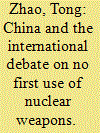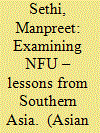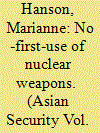|
|
|
Sort Order |
|
|
|
Items / Page
|
|
|
|
|
|
|
| Srl | Item |
| 1 |
ID:
187516


|
|
|
|
|
| Summary/Abstract |
China is the only nuclear-armed country in the world that has an unconditional No First Use (NFU) of nuclear weapons policy. China’s practice of this policy and its impact on international security have important implications for the international debate around NFU and inform other countries’ potential consideration of NFU. Whether NFU policy could deliver the expected benefits of reducing the role of nuclear weapons, containing nuclear arms competition, and mitigating the risk of nuclear proliferation depends on the perceived credibility by other countries of such policy. This paper examines a number of internal challenges that may affect the perceived credibility of China’s NFU policy. One of them is Chinese military strategists’ expressed interest in threatening nuclear use in a conventional conflict under certain conditions through the so-called “lower the nuclear coercion threshold” operation. The others include the lack of institutional constraint in the Chinese system to ensure implementation of NFU and the growing ambiguities about the NFU policy’s applicability in specific scenarios as a result of new technological development. The paper offers recommendations on how China can address these challenges and work with other countries to create the conditions for the international adoption of NFU, including how to address the concerns of nonnuclear weapons states about the conventional-level security consequences. It concludes by discussing how China and the other nuclear-armed states can better fulfill their disarmament obligations by strengthening the existing NFU policy and promoting credible NFU policy more broadly.
|
|
|
|
|
|
|
|
|
|
|
|
|
|
|
|
| 2 |
ID:
187517


|
|
|
|
|
| Summary/Abstract |
The concept of NFU has been around for many decades, but only two of the nine nuclear armed nations have declared NFU doctrines. Both of these China and India, are in Southern Asia, a region that houses three geographically contiguous states with nuclear weapons. Pakistan, the third nuclear armed country in the region, rejects NFU. The paper examines the disparate positions of the three countries in order to find their motivations for and objections against NFU. By understanding their decisions to accept or reject NFU, one can test the strength of the arguments normally made in favour of first use. The paper showcases the utility of NFU as an effective credible strategy that achieves the objective of deterrence at least risk. Such a posture also demands less onerous arsenal requirements, liberates the decision maker from having to lay down redlines on use of nuclear weapons, and eases the ‘'lose or use’' dilemma of the adversary. Meanwhile, first nuclear use presents itself as not only a dangerous but also non-credible strategy, especially where the adversary has a secure second strike capability. Understanding the benefits of NFU and futility of first use can also help shape global acceptability of NFU as a step towards nuclear disarmament. Till such time as all stakeholders can be convinced of the desirability and feasibility of such a world, acceptance of NFU can be a safe way station.
|
|
|
|
|
|
|
|
|
|
|
|
|
|
|
|
| 3 |
ID:
187515


|
|
|
|
|
| Summary/Abstract |
On 22 January 2021, the first legally binding international agreement to comprehensively prohibit nuclear weapons entered into force. The agreement, known as the Treaty on the Prohibition of Nuclear Weapons (TPNW, or “Ban Treaty”) is an important step on the long road to the elimination of nuclear weapons, an expression of solidarity toward that goal. But the Treaty has been roundly rejected by the world’s nuclear-armed states, which claim it will never become part of customary international law due to their persistent objector status, and which continue to value nuclear weapons as security providers in a world of changing power dynamics and strategic uncertainties. This rejection severely limits the Treaty’s impact: regardless of the Treaty’s other strengths and weaknesses, for as long as the nuclear weapons possessors and their nuclear-dependent allies refuse to accept its prohibitions, it cannot play a practical role in taking disarmament forward.
|
|
|
|
|
|
|
|
|
|
|
|
|
|
|
|
| 4 |
ID:
187520


|
|
|
|
|
| Summary/Abstract |
Regimes generally possess multifaceted repressive repertoires. When faced with societal challengers, a regime can utilize overt or covert forms of coercion as well as indirect forms of repression, known as channeling. Using case material from Central Asia, this article investigates the interplay between channeling and coercion in two contexts: 1) the regulation of civil liberties; and 2) Kazakhstan’s efforts to demobilize a protest wave. Through an overview of freedom of assembly laws across the region, we demonstrate that most Central Asian states mix coercive and channeling tactics to limit opportunities for contentious acts. We then analyze Kazakhstan’s repressive reactions to a single coherent national protest wave (the 2016 anti-land reform protest). Our analysis reveals that in response to the threat of these protests, the Kazakhstani regime utilized coercive and channeling tactics in roughly equal measure. We show that the most prominent form of channeling attempted was elite mediation, whereby officials personally encouraged protesters to relocate to non-public spaces and/or offered to articulate collective grievances to higher authorities in exchange for protest dispersal. Through evaluating the role of channeling in this wave we demonstrate how non-democratic regimes can maintain regime stability when challenged without relying solely on overt forms of coercion.
|
|
|
|
|
|
|
|
|
|
|
|
|
|
|
|
| 5 |
ID:
187518


|
|
|
|
|
| Summary/Abstract |
No first use (NFU) of nuclear weapons is said to be an effective declaratory policy for advancing nuclear disarmament. In Japan, which suffered two atomic bombings, there are many voices that expect the US to declare the NFU, hoping to promote nuclear disarmament. In the meantime, Japan faces a tough security environment with North Korea's growing nuclear and missile capabilities and, above all, China's more assertive actions along with the expansion of both nuclear and conventional forces. The Japanese strategic community thinks that it is essential to maintain the credibility of the US extended deterrence and to further develop strike capabilities to counter China's medium-range strike capabilities in the region. In this context, there is a concern that a possible US declaration of NFU, while it may reduce the nuclear risk between the US and China, may signal to China that the US would allow China's assertive activities at the regional level. Measures must be taken to dispel concerns about such regional instability, and stakeholders should pursue stability at both strategic and regional levels so that declaratory policies such as NFU can effectively contribute to reducing nuclear threats and risks. To this end, it would be beneficial to discuss arms control and build confidence through a multi-layered strategic and arms control dialogues among primary players, namely one between the US and China, one among the US, Japan, and China, and another that add other regional players.
|
|
|
|
|
|
|
|
|
|
|
|
|
|
|
|
| 6 |
ID:
187519


|
|
|
|
|
| Summary/Abstract |
Nuclear arms control and disarmament processes have stalled in recent years, and there is concern, especially among non-nuclear states, that the nuclear risk-reduction measures previously called for are not being met. One of the most important of these is the need for no first use (NFU) commitments to be given by all the nuclear weapon states (China and India have already done so.) The idea has been given recent impetus in the United States, especially as President Biden prepares the next US Nuclear Posture Review. Some states under the US nuclear umbrella, however, have expressed resistance to this idea, even as NFU would be highly-useful in reducing nuclear dangers. This paper argues that Australia, even though it is not formally under a US nuclear umbrella, has an important role to play in furthering prospects for NFU. The paper suggests ways in which this might be done.
|
|
|
|
|
|
|
|
|
|
|
|
|
|
|
|
| 7 |
ID:
187521


|
|
|
|
|
| Summary/Abstract |
In the early 2000s, the Middle East was not high on the list of Singapore’s priorities. Of late, however, a more purposeful engagement with the Gulf is evident. This paper adopts an approach grounded in foreign policy analysis to analyze the extent to which Singapore’s engagement with the Gulf is shaped by security-related developments in the latter. It draws largely upon qualitative analysis, interviews, and quantitative data from sources in Singapore. Section one provides the relevant theoretical overview according to which domestic sources, in this case Singapore’s strategic culture of “vulnerability,” frames the conduct of foreign policy. Section two examines Singapore-Gulf relations along three security-related pathways – public order, economic prosperity, and domestic energy mix – and the extent to which they are filtered by the city-state’s “vulnerability.” Section three concludes with some thoughts about the outlook for maintaining the momentum in relations between interlocutors on the fringes of Asia.
|
|
|
|
|
|
|
|
|
|
|
|
|
|
|
|
|
|
|
|
|